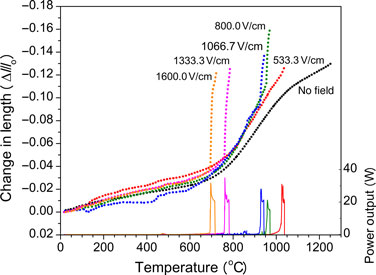Crossref Citations
This article has been cited by the following publications. This list is generated based on data provided by
Crossref.
Luo, Jian
2018.
The scientific questions and technological opportunities of flash sintering: From a case study of ZnO to other ceramics.
Scripta Materialia,
Vol. 146,
Issue. ,
p.
260.
Muccillo, Reginaldo
S. Ferlauto, André
and
N.S. Muccillo, Eliana
2019.
Flash Sintering Samaria-Doped Ceria–Carbon Nanotube Composites.
Ceramics,
Vol. 2,
Issue. 1,
p.
64.
Biesuz, Mattia
and
Sglavo, Vincenzo M.
2019.
Flash sintering of ceramics.
Journal of the European Ceramic Society,
Vol. 39,
Issue. 2-3,
p.
115.
Chaim, Rachman
2019.
Relations between flash onset-, Debye-, and glass transition temperature in flash sintering of oxide nanoparticles.
Scripta Materialia,
Vol. 169,
Issue. ,
p.
6.
De Bona, Emanuele
Walter, Olaf
Störmer, Heike
Wiss, Thierry
Baldinozzi, Gianguido
Cologna, Marco
and
Popa, Karin
2019.
Synthesis of nanostructured ThO2 pellets.
Journal of the American Ceramic Society,
Vol. 102,
Issue. 7,
p.
3814.
Li, Xiang
Huang, Rongxia
Wang, Xilin
Liu, Guanghua
Jia, Zhidong
and
Wang, Liming
2020.
A simple optimized design of an electrode to conduct flash sintering at room temperature and low onset electric field.
Scripta Materialia,
Vol. 186,
Issue. ,
p.
158.
Cologna, Marco
2020.
Comprehensive Nuclear Materials.
p.
811.
Yan, Nianping
Deng, Zhixiang
Cai, Muliang
Li, Xiang
Zhou, Hongyang
Wang, Xilin
and
Jia, Zhidong
2021.
Flash Sintering of ZnO Ceramics at Room Temperature with Bisectional Electrode Distributions.
p.
422.
Porfirio, T.C.
Muccillo, E.N.S.
and
Muccillo, R.
2021.
Electric field-assisted synthesis/sintering cerium oxide: 5 wt.% gadolinium oxide.
Journal of the European Ceramic Society,
Vol. 41,
Issue. 14,
p.
7105.
Muccillo, Reginaldo
de Florio, Daniel Zanetti
Fonseca, Fabio C.
Carvalho, Sabrina G. M.
and
Muccillo, Eliana N. S.
2022.
Electric field‐assisted sintering anode‐supported single solid oxide fuel cell.
International Journal of Applied Ceramic Technology,
Vol. 19,
Issue. 2,
p.
906.
Zhou, Hongyang
Li, Xiang
Zhu, Yuchen
Liu, Jieming
Wu, Angxuan
Ma, Guoming
Wang, Xilin
Jia, Zhidong
and
Wang, Liming
2022.
Review of flash sintering with strong electric field.
High Voltage,
Vol. 7,
Issue. 1,
p.
1.
Muccillo, Reginaldo
Diaz, Julio Cesar C. A.
and
Muccillo, Eliana N. S.
2024.
Analysis of the Luminescent Emission during Flash Sintering of 8YSZ and 20SDC Ceramics.
Ceramics,
Vol. 7,
Issue. 1,
p.
329.





